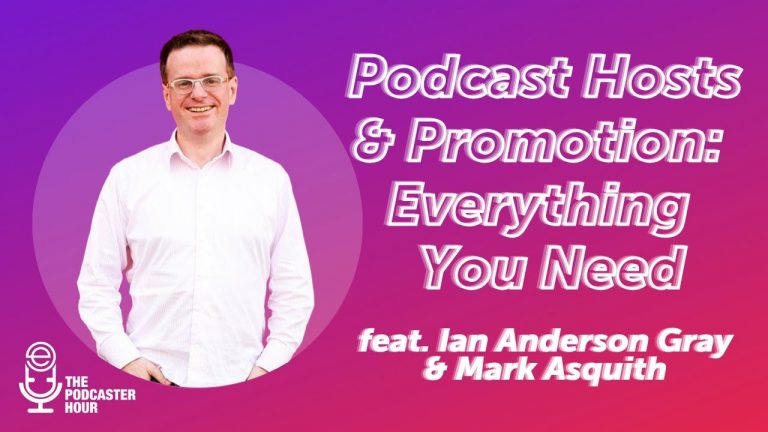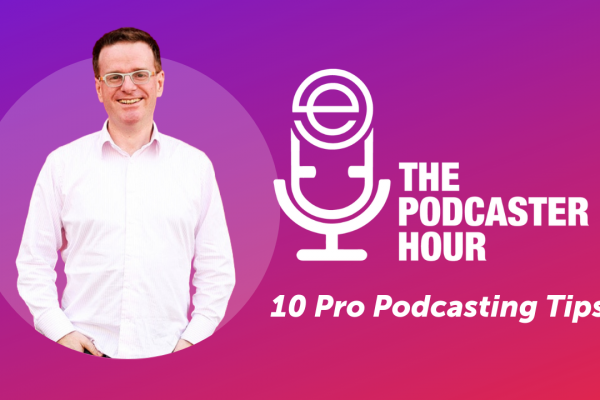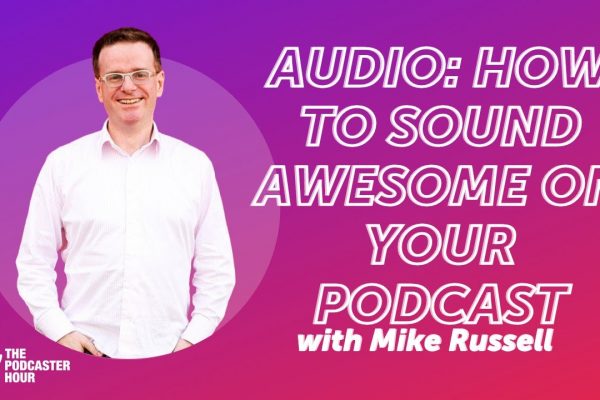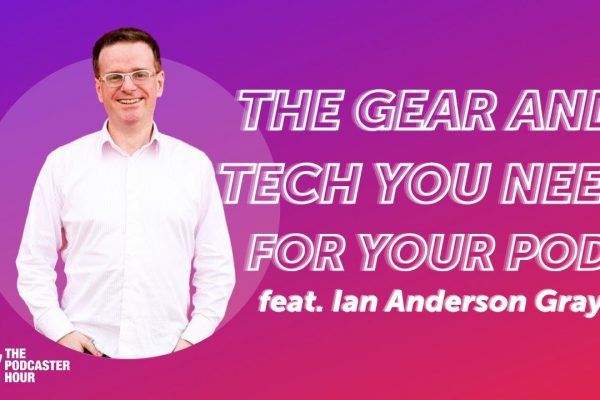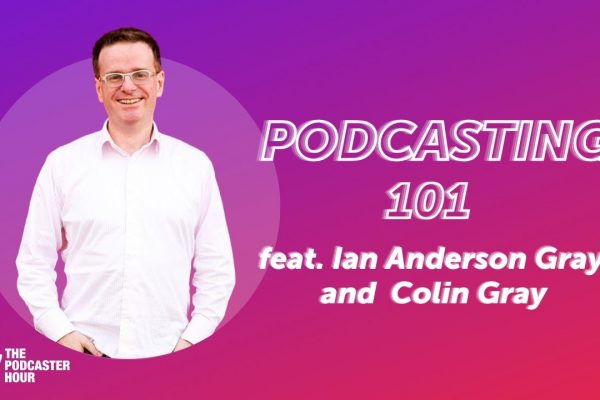Get ready; this is the last post for The Podcaster Hour and it’s a big topic! We’re talking all about podcast hosts & promotion.
We’ve almost covered literally everything you need to know in this series, including how to plan your podcast and live show, top podcasting gear, how to sound awesome on your podcast, and more.
In this post, Ian is joined by special guest, Mark Asquith. Mark is known as That British Podcast Guy. He’s also the CEO and co-founder of Rebel Base Media, and the co-founder of Captivate FM.
He’s been in the podcasting world since before England was awake to podcasts. When he went to conferences, people would ask, who’s that British podcast guy? And the name stuck. He is a podcast veteran, and we’re excited to have him.
In this post, we’ll cover
- What the next step is after producing a podcast
- How to get your podcast out in the world
- How to promote your podcast so people will listen to it
Watch the full episode
Want to learn even more?
ECAMM LIVE (Free Trial) https://iag.me/ecammlive
IAN’S GEAR GUIDE https://iag.me/gearguide
LIVE VIDEO CONFIDENCE GUIDE (opens with FB Messenger) https://confident.live/subscribe
CONFIDENT LIVE MARKETING SHOW https://iag.me/podcast
Introduction
Ian: Well, I’m excited to talk to you today about podcast hosting. We’ve basically talked about everything else. I’ve briefly talked about podcasting hosting on the show, but obviously once you’ve edited your podcast, you’ve got to then get it out there in the real world. So, that’s what we’re going to talk about today and how to promote your podcast.
I’m still laughing about your email this morning that you sent out to your list about “exploding your podcast audience.” Tell us more about that.
Mark: Oh yeah, that was a funny one. I sent out an email with the subject line, “Explode your podcast growth,” with absolutely no intention of teaching people how to do that. It was to call out the BS that you see in the industry. And a lot of industries online, the entrepreneurial industry, the content creation industry, where everyone wants to 10X this and explode the other. It’s 99% rubbish, so I was calling that out a lot of the time.
Captivate’s tagline is “The world’s only growth-oriented podcast host.”
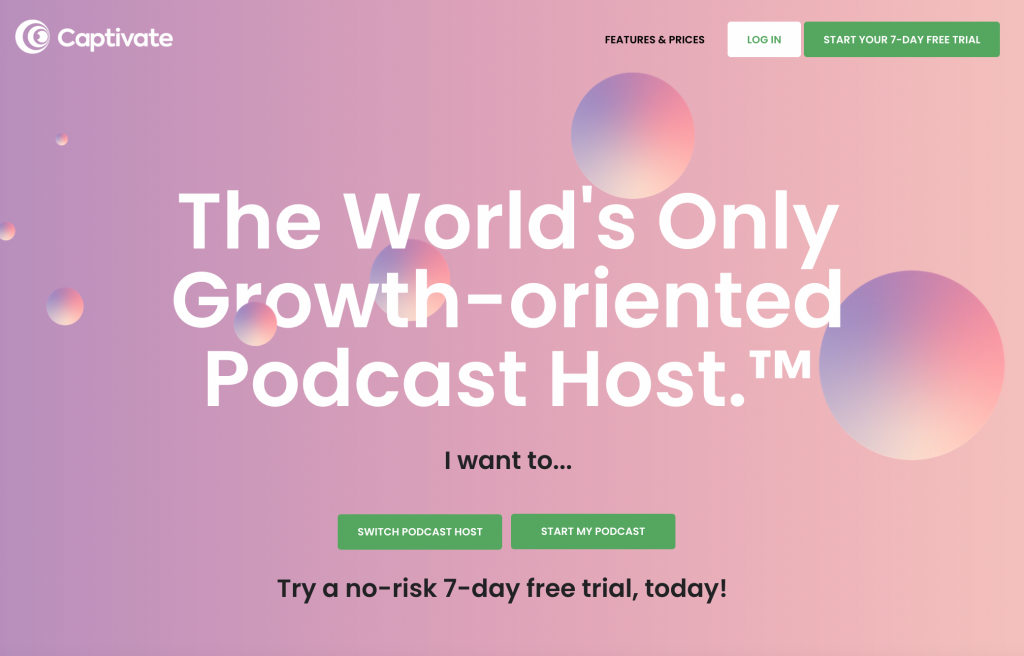
The problem with many podcast hosts is they don’t necessarily help you to grow. I think there’s a difference between some people who help you grow and some people who just provide a platform. In the email, I was kind of calling out many of the people who say they do this stuff but don’t.
I see it a lot in online coaching as well. Everything is $97 down from the $500k for the first 15 minutes only. And you’re like, what are you talking about? It’s not 2012. It’s not 2015. Let’s just stop doing that.
I genuinely see two things. I see people buying subscribers, listeners, and reviews. And I also see on the other side of the spectrum people making six figures a year from sponsorships with three-figure downloads. I’m talking per episode less than a thousand downloads. You have to understand what’s going on.
So that’s what the email was about.
Ian: I love that. And I love the way you say that straight, because there is a lot of stuff out there that’s rubbish and at the end of the day, what is it that you’re wanting to achieve?
So I’d be interested if you’re watching live or watching the replay, what is it you’re wanting to achieve with your podcast? What audience levels do you want? Do you want 10,000 downloads per episode? Why do you want that? What is the actual outcome that you want to have? We’ll talk about that today.
What is a podcast host?
Ian: Let’s talk about what a podcast host is. Let’s get right back down to basics. We’ve edited our podcast and now we’re ready for the world to hear it. So what do we need to do?
Mark: There’s a few different things with this one, and it’s all about the outcome and how much you’re willing to spend a month. You can do a lot of amazing things for $6 bucks a month, but imagine what you can do for $10 bucks a month. It depends on what you want.
When you go to launch your podcast, you’ve got to get plenty of reviews. You’ve got to get plenty of ratings. You’ve got to do three to five episodes so that you can crush new and noteworthy and really up your listenership. You need subscribers and all that guff.
But, that’s a little bit old school advice. You’ve got to realize what you’re trying to achieve with your podcast. What you’re often trying to achieve is only one of two things.
Number one, you want to build your network. You want to meet people like Ian, who can help you to enter a brave new world. You’ve taken your first step into a larger world. You want to be the Luke Skywalker entering this new wide world and just finding out all of these new people in these new things.
Goal number two is to make some money. Now, they can really coexist as two primary objectives that can coexist, but one of these objectives, make money or build your network, has to be the primary one and the other one is the secondary one.
The point is, if you want to make money, you’re only going to be able to do it in two ways: sell something or sell some people. If you sell something, it’s something that you are selling. So let’s assume that on Ian’s podcast, Confident Live Marketing, Ian wants to sell something of his.
He has to be the man. He has to be the live stream, the live marketing, the live guy. And he is; everyone knows Ian for that. So that’s one fantastic facet. If you’re going to sell your own thing, you have to be the center of attention. If you want to build your network, interview shows and so on, they’re a fantastic way to do it.
Now, I know you’re thinking, “Well, Ian asked me a little bit about what to do after launch.” What happens is that there are two sides to a launch. There’s the technical side and the technical launch, the ability to make podcast X appear in-app Y.
Then there’s the question of what do you do to grow the podcast? What do you, the person, do to launch this thing? People think they’re the same thing, and that’s because you get a lot of bad advice from bad courses where people say, Get into Apple podcasts, get your ratings and reviews, get into new and noteworthy, and they think that’s enough. But it’s not. That’s the technical launch.
So what do you do?
First, you need a hosting platform, which is just a little bit of middleware that sits between you, the broadcaster talking into a microphone, and me, the listener listening on my earphones. Hosting platforms work by you taking your produced audio files and popping them on a hosting platform like Captivate.
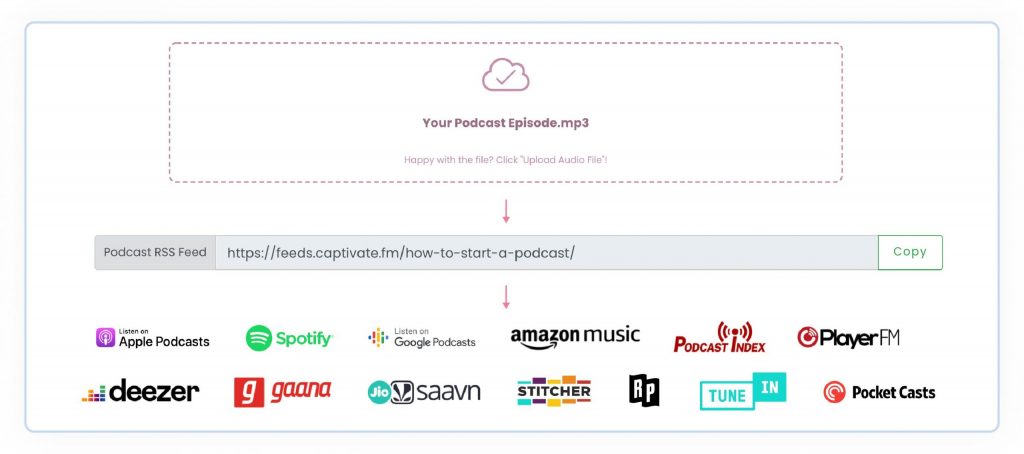
The hosting platform then wraps them all up along with all of your settings and all the information about your podcast and puts them in a box called an RSS feed. The RSS feed categories the podcast as Episode 1, Episode 2, and so on. It contains labels stuck on the outside of the box with your show description, the cover art, and more.
Then, the host does a couple of different things. It lets Apple, Spotify, Google podcasts, etc. know about this box of content. It measures when people listen to what’s in the RSS feed, which means it gives you analytics. That’s the most basic piece of podcast hosting. I’m sure we’ll get into more specifics later, but that’s what a podcast host does.
As for what you do after launch, there is a range of answers. But, to leave this segment for now, which I’m sure will lead into another question, but the podcast launch should always be treated as a two-step process.
In step number one is your prelaunch, which includes the technical launch and some best practices around generating subscribers before the second phase, which is the physical launch, or the marketer launch.
Ian: Really love that. That’s quite good because that’s kind of what we’re focusing on right now: stage one, which is the technical launch. I haven’t quite thought of it in that way, but that makes total sense. We’ve edited the podcast. We’ve put all that together. There’s the whole PR, the process, the planning, all that kind of thing. That leads up to us getting it onto all those different directories using a podcasting host. Let’s focus on that first before getting to the marketing side of things in phase two.
There are loads of different hosting companies out there. I had a podcast about 12 years ago, and I think I had it on my WordPress site using plugins. Then I used SoundCloud, and it was all complicated. These days, that’s not what we do.
Now, we use a podcast host that hosts an RSS feed. It’s not complicated at all; the podcast host basically creates it for you. You upload your episodes to the podcast host, and that generates the RSS feed automatically. Then you can plug that into all the podcast directories.
Do you want to fill in the gaps, and then let’s talk about what Captivate does?
Mark: Yeah, absolutely. You nailed it. The reason we created Captivate is that most hosting platforms just do that small bit. We wanted to do more; we wanted to create more growth-specific tools to help you grow your show.
With Captivate, we work directly with Apple, Amazon, Google, Spotify, Player FM, Gaana, Jiosaavn, all of these different places. It generates the RSS feed and gives you the older, embeddable podcast players, everything that you need to engage your audience.
Distribution is the first part of it. Get your audio files onto a host like Captivate, then distribute to Apple, Spotify, Google, and then start growing the thing. That’s the flow.
Ian: Yeah. That makes total sense. And, I mean, Mark is from Captivate. Captivate is Mark’s baby. There are plenty of other hosts out there, and you need to do your own research and find out what works best for you. What I love about Captivate is that it’s so easy to put together. You don’t have to spend loads of time working out the technicalities of RSS feeds, and you don’t even really need to know what one is.
The other great thing about Captivate is its distribution.
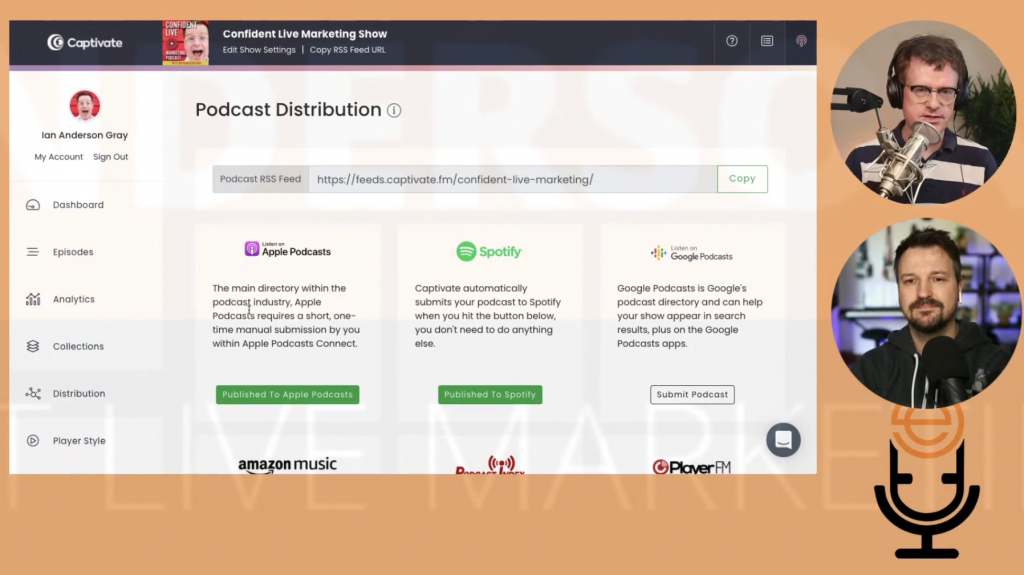
I’ve used other hosts in the past, and they were difficult. Captivate, on the other hand has one-click buttons that pop up to submit to various streaming platforms. Maybe if we could go through some of the directories, you can briefly tell us what we need to do to submit to those channels and the pros and cons. Should we start off with Apple podcasts?
Mark: Actually, I can categorize them for you. The vast majority of them are one-click. This is one of the things that we are really handy at because we move really quick. We release new features every Thursday. We add many of these distribution channels because they are so API-focused. What that means is we do one-click data sharing, one-click analytics, and one-click submission. We have direct integration with each one.
For Apple podcasts and Google, you do still have to add the RSS feed on their site manually, but there are really only two categories. Some are direct pass-through, like Spotify and Amazon. Then the ones you manually submit to. Google does operate a bit weird because it actually crawls your website.
Always do your research. That’s how I started Captivate—from doing my research. I had the same setup as you do that I was using another host, and I was using something for WordPress. It was a pain, and I was like, what’s the point? , there has to be an easier way. So we genuinely built Captivate to scratch my own itch. Now, when you look through Captivate, you’ll see that. I mean, it’s your person. Everything’s easy because distribution shouldn’t be that hard.
That’s really what you need from a podcast host. If you are constantly worried about tech and making sure everything is set up and working correctly, you’ll never have time actually to record your podcast. That’s the great stuff you can do and enjoy, but you’ll not spend any time growing it. And then what will happen is you’ll quit podcasting because podcasting doesn’t work for you, or tech held you back.
Our job, in podcasting, is frankly to demystify a lot of that. Stop being so old school and complicated. That’s a real kind of mission statement of Captivate. I know that’s a slight digression, but I think it helps to quantify why your time is so paramount in podcasting.
If you’re not growing your podcast, it’s probably because you haven’t put the time in, because you don’t have the time. So let us give you the time back.
Ian: I think that’s really important. I think there’s certain things that you absolutely need to invest that time into, and delving into the intricacies of RSS feeds and WordPress is probably not one of them, unless you’re a total geek like me and Mark. I think I used to enjoy it, and I just don’t think I would enjoy that anymore. Now I just want to focus on creating that content. And that’s what using a host like Captivate will allow you to do.
Okay, so we’ve got a host. Would you recommend that we just submit our podcast to all of those players on the Captivate page, or are there two or three that we should focus on? What’s your view on that?
Mark: All of them, and that’s why we built distribution to be like that. I’m not a fan of the whole “be everywhere” scenario. I don’t think it works. I think it’s a nice idea for those that can outsource everything. I’m always a fan of picking one or two channels, but in podcasting, you don’t know people’s preferences when it comes to consuming content. It’s like being able to get the Netflix app on my Playstation, Xbox, TV, Firestick, Apple TV, and my phone. It’s not about being everywhere, it’s about having access to the content everywhere. So get in all the apps.
There’s an inherent problem in podcasting, which is the word subscribe. Now, why is it? Well, we only use the word subscribe in podcasting for one reason. Because RSS is predicated on subscriptions. If you think RSS was an old blogging technology, really simple syndication, it basically meant that every time I put a new blog post out, then the readers could get that, and they could give it to me, the reader. RSS is predicated on this old technology where the word subscribe is prominent in its ecosystem, but it’s a problem.
What else do we subscribe to? Well, we subscribe to Netflix, like we just talked about, and Amazon Prime. We subscribe to Graze boxes and to comics, and to magazines. And we subscribe to the software, and guess what? All of that is paid. We pay for everything else that we subscribe to.
So we’ve kind of got this inherent challenge. Yes, number one be everywhere. Just submit, it’ll take you five minutes to do that. But here’s a little tip. When you do your podcast launch, launch with a trailer.
Now, all the old advice will say to launch with three episodes, and how many ratings and reviews makes not one bit of difference. Instead, we have to get people to press that weird little subscribe button before we launch our podcast in phase two.
So we launched with a trailer, we do a pile of marketing around the trailer, and one of my calls to action is, Hey, press that subscribe button in Apple podcast. When I release the first three episodes, which I’ll do so that you can binge them, you can enjoy them. You can really get hooked on me. You’re already subscribed and you’ll get them sent to you. You will just get them in your podcast app. So that’s a little launch hack that not many people are teaching, but it works.
Album covers
Ian: I think that’s great. That reminds me of a few things before we get onto the promotion side of things.
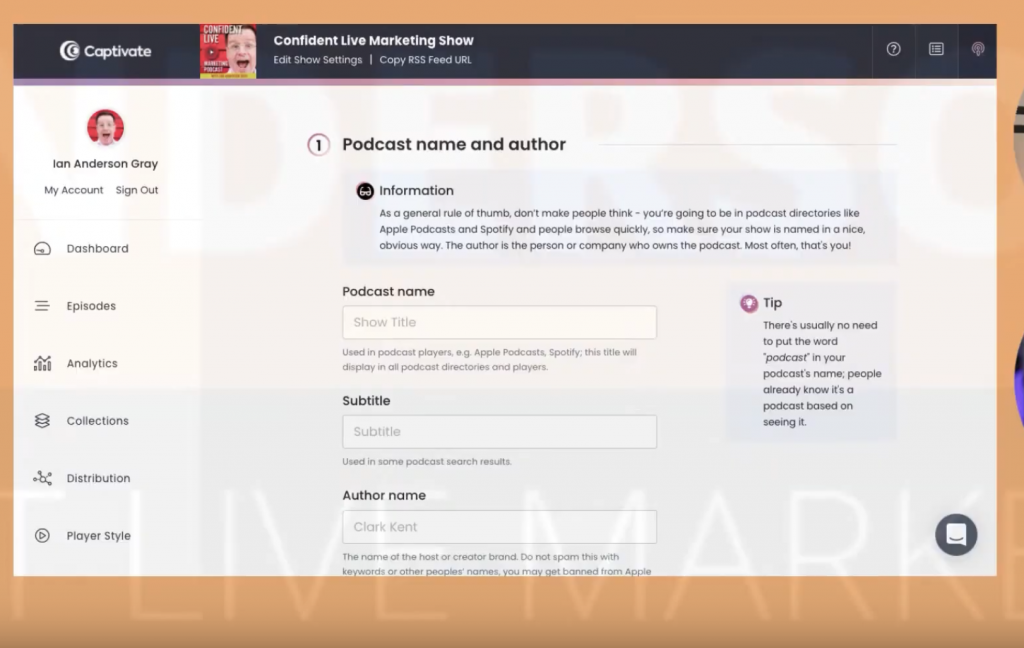
When we’ve created the podcast episode we go into, for example, on Captivate, if I’m creating a new show, we’ve got to fill in a few details here, we’ve got the podcast name, subtitle, all this kind of stuff, and then we’ve got cover art and things like that.
Can you just briefly take us through all the things that we need to think about when we’re creating this? Particularly when it comes to cover art, because I know that that kind of freaks some people out because they’re not really sure what they should be doing there.
Mark: Let’s pretend that I’ve got a CD. Your album cover art is basically what your podcast cover is. What a lot of people do is they’ll think they can do it themselves. You probably can’t, and that’s a fact. I’ll tell you why. It’s a square image that sits at the front of your podcast, and it’s the album art. Since is the one thing that people see, it becomes the poster for your podcast and is probably the most important element of your podcast’s discoverability.
There’s a couple of other things like your title and so on and so forth. But, it’s up there as one of the top three things for discoverability. So it’s this square artwork. It goes on the front of your podcast, and you can do episode-level artwork as well, which is another conversation.
The cover art has to be between 1400-pixel square and 3000-pixel square, and under 500 KB in size. It has to look nice. Can’t have swearing on it or any of that stuff. A lot of people do a few things weirdly on their cover art. The biggest mistake is putting yourself on there. I’ve been in podcasting for nearly 10 years, and I just put myself on the cover because people know me. Unless you’re a celebrity, there’s no point in putting yourself on there.
So that’s a mistake that people made. The second mistake people make is they get really cute with their podcast title. You can do this well if you’re a cute guy, but you should keep it simple. Ian, you’re a cute guy, but your podcast title doesn’t try to be cute. My podcast, The Podcast Accelerator, simple as that. What a lot of people try and do is they’ll try and introduce these fancy concepts on their cover, where they introduce a really cute name. And if you read the tagline to the show, it’s all explained what that cute name means.
The problem is the cover art is about as big as a square on a Rubik’s Cube. It’s tiny. It won’t get read. So that’s a mistake that people make: they put themselves on there, they go for a cute name, and they explain it away in a tagline that’s bundled up on the cover. Wrong.
What you have to do is think about this. People are scrolling through Spotify, they’re scrolling through Apple, etc. And why are they scrolling? Because the thing that you want to rank for in Spotify and iTunes or Apple podcasts, as it is now, because they are of course, search engines.
The thing that you want to rank for has been searched for. They’re scrolling trying to find the thing that they want to listen to, which one do they stop on? The one that catches their eye, not the one that tries to explain what’s going on.
This is just an actual fact of podcast marketing, and it’s a reason that movie posters exist. The album covers are designed to stand out on a shelf. It’s very rare that a debut album will have a picture of the debutante, the artist on the cover as the main piece. It might have them on, but it’s very rarely the main piece. Usually, it’s a conceptual thing that kind of stands out on a shelf. So think about that with your cover. It’s vital because it really is, in my view, certainly one of the top three things that you should get right for your podcast.
Now you can’t design this yourself, and I know you think you can. I’ve thought the same. I am not a designer. I can fire up Canva and I can create a square that fits the specifications 1400 pixel square to 3000 pixels square. But I can also mix up a bit of Gabo and throw some bricks up, but I’m not going to live in it.
The situation is that you only really get one chance to get a prospect to listen. And you have to catch their eyes. So you don’t have to pay for your design. But if you don’t want to pay for your design, please use a template from Canva and don’t customize it too much. Just change the name, maybe tweak it ever so slightly. But remember that those designers have designed that template like that for a reason.
Ian: Yeah, totally great. And I agree with you. Ideally, get it professionally designed, but just don’t do it yourself. I mean, I’m exactly the same as you. I’m not a designer. I like to think I know what looks good, but that’s about it really. So yeah, the podcast art is the cover. Art is really important. The title is really, really important.
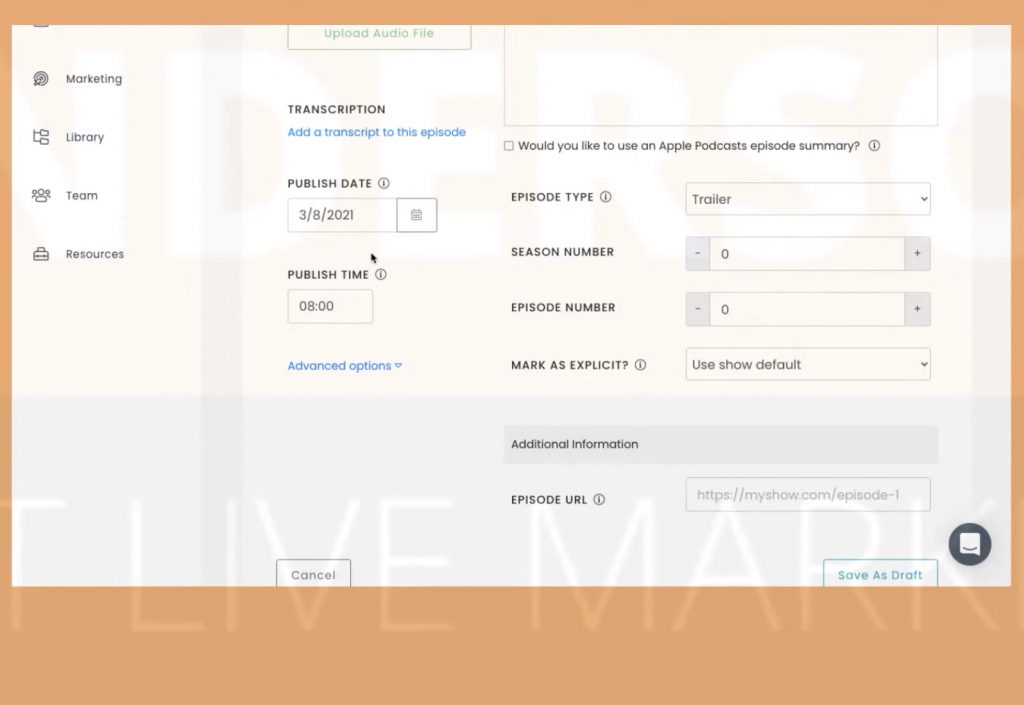
Then just briefly, we were talking about. You started off with a trailer. So this is one thing you can do in Captivate and presumably other hosts as well. So you can set what is the episode type? Is it just a normal episode? A trailer? Is it a bonus episode to create a trailer? You’ve also got the option to have seasons as well. We had Colin Gray on the show talking about the advantages and disadvantages of having seasons. And then of course you’ve got the episode numbers as well. Anything more to say on that screen, Mark?
Mark: Yeah, a couple of things. Number one, the published time is a Captivate-only feature. No one else does a default publish time. So we allow you to set a default in your show settings. If you always want to publish at 9:00 AM, that published time will always be defaulted to 9:00 AM. That’s because I’m lazy. I don’t see the point in changing the time, every time. So we built that default thing in.
There are a couple of things on there that are a little bit more advanced than I think you should be using. You see that little chat box there that says, Would you like to use an Apple podcasts episodes summary? The answer should always be yes. The summary should be just a paragraph, a really small two- to three-line paragraph, because what that does is it acts like a meta-description in Apple Podcasts and Spotify.
If Apple Podcasts doesn’t have one, what will happen is that it will take all your show notes that you’ve really nicely formatted and it will just smush them together. It will take all the formatting out. So put a summary. And even if it’s just one sentence, always summarize your episode.
Another couple of nifty things as well that I think a lot of people will get some benefit from: transcriptions. You can add a transcript to each episode. Very, very good for accessibility and decent for long-tail SEO. There are also a couple of important things in the Advanced section.
We allow private podcasting on Captivate. We’re the only host that lets you create an internal podcast just for private subscribers, with up to 150 subscribers. No other host does that for free; you’ve got to pay for that. You can also create some privacy here by taking this episode out of the RSS feed.
So let’s assume that Confident Live Marketing produces episode 100, and you say, guess what? For everyone that’s a member of my membership, I’m going to embed a special episode onto my website, but I don’t want to create an entirely new private RSS feed-driven podcast. I can publish that bonus episode for the special listeners, exclude it from the feed, and embed it.
That is very good for membership owners and people in the business space who want to launch a podcast successfully. Why? Because there’s nothing better for building fans and advocacy and podcasting than letting people in behind the scenes. It’s why live streaming is a great compliment to podcasting, and podcasting is a great compliment to live streaming, whichever your focus is. So that’s very useful.
And the last thing that I’ll mention is that set episode expiration date. There are two ways you can use this. One of them is innovative and the other is not. Think of it like one is actually innovative and the other is air quotes “innovative.” The air quotes innovative one is like Christmas messages, Easter messages, International Women’s Day messages.
If you want to put something out that’s timely, you can then remove this automatically from your feed later. But the reason I mention that one is because when it comes to launching, this can be very powerful. Here’s an example. You say, here’s my trailer, blah blah blah, and if you subscribe right now, you will hear a bonus episode that will disappear within two days.
So you hit the subscribe now, and you are going to get that. Oh, here’s a sneak peek of episode one, click the subscribe button, get ahold of it. You can use it to your advantage. I don’t really like adding scare stuff. I think a lot of it’s rubbish, but in this case, I think you can use it to your advantage by not being too bolshy on it.
You’re just giving people a little bit of teaser content that you then pull back later. It’s very handy for launching.
Ian: I love that. Really fabulous advice there. I haven’t been using the Apple podcast episode summary, but I’m going to from now on.
Mark: You know, another tip as well. Use episode-level cover art. More and more directors are doing this. They’re respecting the episode-level artwork, and it will make your episodes stand out amongst the sea of others. Every other podcast uses just the cover art for the main show for every episode because it’s just a default.
If you used episode level cover at the same spec, but make it look different, put the title on, it will really stand out. Now, why is that important for launching? Well, honestly, Google podcasts have got such a focus on episodic-level consumption. It’s not pushing people to subscribe. It’s surfacing content at search result level that is episode specific.
If you search for something Star Wars-related and we’ve done an episode about it, the episode (not the show) will appear there. Now, what gets clicks-throughs? We know that what gets click-throughs is relevance. What’s more relevant than the featured image? The episode image matching the search query. So get into the episode-level stuff, and people tend to do this after like episode 100, but if you do it early, you will already be ahead of so many podcasts.
Ian: Well, that’s me. I’m over episode 100, and I’ve not been doing it, but I think it’s a great idea. I’m going to start doing that because I’m creating art for every episode anyway.
Promotion
Now we’re going to be talking about moving over to promotion. We’ve got a question here also about how to promote a podcast so that more people than a fraction of your friends on social media will listen to.
Mark: Well, why do you want to? Think about it. If you’re launching a new show, you want to accelerate something. You might not have the time to learn how to be a marketer, too, because no one tells you that’s the bit that you’ve kind of got to get under the skin of, in order to grow this thing. You might think, wait a second, other people have this amazing growth, and I don’t. But that’s how you start.
You are producing a piece of content that you can’t see me on. Okay. All you can do is pipe my voice into your ear, and that’s really intimate. That’s really powerful. Whenever you’re building anything, you start with the inner circle, which is your friends and it’s your family, and it’s everyone else. Then you build it out. What people don’t do is just ask their friends and family to take action, to do something, to help, to share that experience, to go through the process of helping other people to subscribe.
So why bother with all of this online difficulty to start with? Why not talk to the people that you already know, the people that inspired you to like this. If you can get to 500 listeners, a hundred listeners, 50 listeners, because of your niche and because of where you are, you will get sponsorships.
I know people that make six figures in sponsorship with three-figure downloads, like I said earlier. This is one of the biggest myths in podcasts, that you’ve got to explode your growth, or you’ve got to do crazy social media, or you’ve got to build this huge email list. All of that is amazing, but get to the followers that you can get to first.
The people around you will listen, and importantly, they will tell other people about it. Now, what can you do to add to that? You can do some pretty cool stuff, right? Instead of spending your money on social media tools and buying apps, spend a hundred bucks on some badass merch.
Get yourself some nice stickers or anything branded for your niche. Just give them away. The kicker is this. There are so many people that are ready to listen to something that you are producing because they love the thing that you talk about, but they don’t know about podcasting. So on this merchandise put, Listen to my on-demand audio for free by clicking this link.
Now, if you’re a Captivate user, you get a single subscription link. You can just go to whatever your demand is /listen. That gives them the place to go and listen and subscribe. All right. Why is it important to do that? Because it’s easier to access people that love what you talk about than it is to figure out how many people like podcasting. And out of those people, who likes my stuff?
Be the person that educates, buy some merch, and get it out into your local area. I promise you will be surprised how many people want to get involved.
Ian: That’s good stuff. I think there’s so much advice out there on how to explode podcast shows. And it’s really important to think, well, who is our audience? Who do we want to see to listen to our podcast? I think also we need to be realistic about what kind of downloads or subscribers we should be looking for. Is that the most important thing? Like you said, someone with three-figure downloads can still get good sponsorship deals.
So with that question in mind, what kind of downloads should we be looking at to begin with? When we launch our show what should that focus be? How do we know whether our podcast is a success? Should we be looking at that on day one, in the next four weeks, or the first year?
Mark: How fast do you want to run a mile in? Who cares? Is it faster than you did yesterday? That’s what matters. The reason I asked that question and again, being a little bit flippant, is that unless you put a figure on it, you don’t know whether you’re successful or not. And that’s the situation. How much is enough? Just put a target on it.
The average podcast episode, not monthly downloads, gets around 138 downloads per episode. If you’re above that, you’re above average. What you should be thinking about is how do you do something that will move the needle? And, what is the actual KPI? Unless you are selling sponsorships to your show, the number of downloads doesn’t matter. It’s what’s around the downloads that matters.
You want to grow your email list. Keep telling people to get on your email list. If you get 10 more listeners and only one of them subscribes to your email list, up to that number from one to two and from two to four and four to eight. You’ve got to put these KPIs around your podcast.
When I first started my podcast, I did 150 episodes of an interview podcast because goal number one for me, actually, I had two goals. Number one, learn what was wrong in podcasting. And I spent a lot of time and money going to the conferences and speaking at them.
But the precursor to that was to be able to get speaking gigs, so I interviewed people like you. I went from being a guy in Barnsley to someone who knew a lot of people. If that’s your goal, what are the KPIs? Speaking gigs, inquiries, what does that look like? Okay. But then what you’ve got to think about then is that the downloads are just the means to the end.
If the conversion rate shows that you get 10 downloads of your Ebook through your lead magnet. If you’ve got 50 subscribers, the first thing you do as marketers, of course, has changed that 10 to 20. And then you try to scale the 50 to a thousand so that proportionally scales and you get more of the right thing.
Podcasting’s no different. So, how do you grow your numbers? What should we go with? Do a Google search for Listener Acquisition Flow and the Podcasting Discoverability Triangle.

It’s a strategic marketing concept for podcasts that I’ve put together, and it talks about how you grow your downloads by targeting three or four different types of people. You start with people that know you, because how many friends have we got that like the thing that we talk about on our podcast? Probably a decent percentage because that’s what friends do.
So you work out from that epicenter and build repeatable marketing processes for your episodes that allow you to automate a little bit of that. Then as you start building out, you think to yourself, There are three types of people that listen or potentially would listen to podcasts:
- People who know about podcasts, but don’t know about me
- Those that don’t know about podcasts, but love the thing that I talk about
- People who know about me and know about podcasts that want to share so that I can access more of the other two people
You’ve got to build strategies for those. The easiest place to start is by targeting people who love what you do but don’t know about podcasting.
Should downloads be at the center of everything that you do? No. Should they be measured? Yes. Should they increase? Yes. Should they have a target? Yes, but they’re probably the highest up the ladder they will get, unless you’re selling sponsorship, is number three. There will be at least two other metrics that should be higher in my view.
Financial metrics are misleading. If your goal is to make money, focus on solving pain points for the listener. Add value and listen and ask people what they’re struggling with. The downloads allow you to ask more people the same question. To answer the question directly, if you’re above 138 downloads per episode, you are above average.
Final tips
Ian: Well, that’s good to know. Thank you for that. We’re out of time, really, but are there any kind of final thoughts in terms of growing your podcast? Are there any tiny things we can do on a regular basis, or is it just hard work and doing what you’ve just said, which is to encourage the people who aren’t normal podcast listeners to listen to our podcast?
Mark: Definitely, man, thank you for having me. It’s been a pleasure. A couple tips are, go and copy the trailer format. Just search for: Mark Asquith Trailer Format. Steal that. Download the Crib Sheet from the Podcast Success Academy because the trailer format is in there, too.
The single biggest thing that you can do to grow the podcast, and the quickest thing that you can do, change all of your calls to action. Change them from, “I’ve just put a new episode out with Ian, go and subscribe,” change that to “I’ve just put a new episode out with Ian, listen to the trailer for the show to see whether or not you will like it.”
Why? I don’t care about Ian until I know about him. When you get to know him, you love him. He’s one of the nicest guys you’ll ever meet, but if I see his picture scrolling on Twitter and I’ve never seen him, I don’t care. We’ve got to make people care. The way you do that is by asking them to put 90 seconds, not 45 minutes, of their time into the trailer.
The last tip is part of that. In your trailer, I want you to curate your best episode. Go to your podcast analytics (or, if you don’t have those yet and haven’t signed up for Captivate, guess which you think your audience will like the most), and your call to action within your trailer is to go and listen to your best episode.
Here’s an example: “Hey, this is Mark Asquith. I teach people how to build their podcast when they are really, really busy. If you want to grow your podcast, I release every single Monday and Friday. And if you’re interested in learning more, go and listen to episode 27, where I go and talk to Ian Anderson Gray about why live streaming is the number one way to boost your reach as a podcaster. See you soon.”
That’s it. You send people to the trailer as your call to action. And then in that trailer, curate people to your best, most downloaded episode. When most people are asking others to subscribe, this tip will put you to the top.
Ian: I love that. It’s so powerful. I mean, it’s just a simple thing, but investing 45 minutes of your life in a person that you don’t know, podcasts that you don’t know anything about, is quite an ask. That’s really great advice. Well, thank you, Mark. That’s amazing.
So obviously, people can find out more about Captivate and can stalk you on Twitter. Where else?
Mark: People can go to the Podcast Success Academy for more help as well. It’s got everything from the trailer format you can steal to life coaching every Friday.
We’re here to help!
Wherever you are right now, you’re not alone, and we’re here to help.
Join the Ecamm Live Community to network with other live streamers like you, grab Ian’s live streaming and podcasting gear guide, and try out his live video confidence guide.
And if you need another podcast to listen to, may we humbly recommend the Confident Live Marketing Show.

